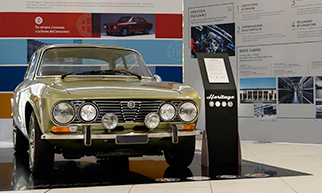Its mechanical refinement immediately distinguishes the first car from the newly founded Lancia & C., showing the world the technical qualities that so quickly made the Turin cars suitable for sports use.
It was the dawn of motoring: on 29 November 1906, Vincenzo Lancia – former chief test driver and official Fiat driver – founded Lancia &C., a car factory based on Via Ormea at the corner of Via Donizetti, in Turin. Alongside him, another former Fiat test driver, Claudio Fogolin. The next year, the first chassis complete with engine was ready, with mechanical refinements to allow a higher rotation speed than that of contemporary cars: an advantage that enabled it to deliver more power and to stand out as a cutting-edge technical choice.
The debut of such a complete car took place at the Turin Motor Show in 1908 when the Lancia Tipo 51 was launched. In 1919, Vincenzo's brother Giovanni, a literature teacher, suggested using the letters of the Greek alphabet to name cars: Alpha thus became the letter attributed retroactively to the first car. As was customary for initial production, the name of which related to the taxation regime in force at the time in Italy, it was therefore given its full name of Lancia Alpha 12 HP.
The Tipo 51 was created with the mechanical refinement that would become a hallmark of every Lancia: over the years, multiple patents for technical innovations were registered by the Turin-based manufacturer.
The engine consisted of two twin-cylinder blocks coupled to form an in-line four-cylinder; the use of boldly combined materials denoted the technical flair based on experience gained in racing: the head was fixed, the two cylinder blocks were made of cast iron, whereas the crankcase was in aluminium. The specifications were completed by a camshaft and side valves, high-voltage magneto ignition and a Lancia carburettor. The first 2,543-cc units delivered 24 hp at 1,450 rpm, soon rising to 1,800 rpm, which took its power to 28 hp.
Not only did the engine stand out: the transmission system was also innovative; at the time, a gearbox was usually made in pairs consisting of sprocket, crown and chain, as on the first motorcycles. Conversely, Lancia used a shaft with universal joints to bring motion to the rear wheels: a cleaner, more robust and reliable solution that would later be adopted by all car manufacturers.
The overall layout featured a sturdy steel frame consisting of side rails and crossbars for anchoring the mechanical parts and chassis, on which the bodywork was then fixed.
As well as the complete chassis, the Lancia catalogue included five different body solutions: luxury coupé, double phaeton, limousine, landaulet in two versions with fixed or removable middle part. Production was 108 units between 1907 and 1909, plus a few – probably no more than five – models in the ‘Corsa’ version. In addition to Italy, the 12 HP also achieved commercial success abroad, especially in the United Kingdom, but also in the United States.
Driven to do by his mechanics, Vincenzo Lancia took the Sport version of the 12 HP to the racetrack. Success crossed the Pond and the Lancia Alpha Sport 12 HP obtained its greatest victories in the States.
Initially, the new entrepreneur from Fobello did not look favourably on direct usage in races: he had several doubts because he knew the high costs and the considerable expenditure of time and human resources. But his mechanics, with Fogolin in the lead, spurred him on, stimulating that spirit of competition among the first car manufacturers, who viewed racing wins as a great opportunity to show wealthy customers the qualities of their cars.
Certain coupé cars gave rise to racing versions named Sport, more lightweight in terms of their superfluous components; it was clear even then the extent to which weight negatively affected performance. The rear cabin and passenger seats therefore disappeared: without its bodywork, the chassis weighed just over 700 kg.
The basic layout remained unchanged, with the innovative rigid axle front suspension on semi-elliptical longitudinal leaf springs. The extensive use of wood, not only in the floor, but also in the spoked wheels, helped to keep the weight down. Among metal alloys, brass stands out for its ductility in parts not subject to mechanical stress, such as water radiator elements, ducts, mouldings and various accessories.
The braking system – one of the most effective of the time – provided pedal control by acting on the transmission shaft, whereas the two drums on the rear wheels were controlled by a lever on the driver's right-hand side, next to that of the four-speed gearbox. The car was driven on the right, better to be able to keep an eye on the edge of the rough roads of the time, often still unpaved. For many years, it would remain a hallmark, almost a habit for “Lancisti” fans, to own and drive right-hand drive cars.





